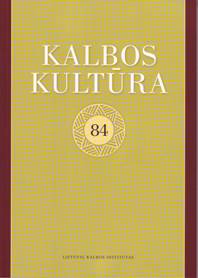Nauji 2007–2010 m. lietuviškos kilmės vaikų vardai ir jų davimo polinkiai
New personal names of Lithuanian origin in 2007–2010 and tendencies of giving them to new-born babies
Author(s): Daiva SinkevičiūtėSubject(s): Baltic Languages
Published by: Lietuvių Kalbos Institutas
Keywords: name; a name of Lithuanian origin; children’s names; two-stem personal name; truncated name; appellative name; suffixal name;
Summary/Abstract: The paper discusses names of Lithuanian origin, which were hardly ever given to babies some time ago but appeared in the Republic of Lithuania in 2007–2010. The paper aims at identifying names which contribute to the expansion of the Lithuanian onomastics. The key factor in the discussion is the novelty of the name; a distinction is drawn between the names suggested by the authors of the Lietuvių vardų kilmės žodynas (Dictionary of Origin of Lithuanian Names) and newly coined names, which are divided according to origin to two-stem compound, appellative, locative and truncated names. Many new names emerged as a result of human creativity; most names listed in the Dictionary had already been given to new-born babies. In the names given between 2007 and 2010, most names are two-stem compound, appellative names and truncated two-stem names; of them, appellative names and truncated names are often expanded by suffixation. These types of names are characterised by the following features: 1. Two-stem compound names are coined on the basis of usual stems; however, there are cases when one of the stems is appellative, of appellative or foreign origin. Such tendency in coining new compound names is not new; it was observed in old two-stem compound names as well. The same principle applies when new borrowed names are recreated. According to the frequency of stems, in female names the second stem mant- and the first stem ai- clearly stand out. 2. Appellative names are coined in two ways: the base of unsuffixed names is usually expressed by the lexis referring to nature; the base of suffixed names is expressed by appellative names with the same stem. Suffixed appellative names, like suffixed truncated names, are built with the help of suffixes, which are of foreign origin in the new names as well as in Lithuanian hydronyms. Such names are considered acceptable. 3. The abundance of names originating from truncated names attests to a general tendency towards shortening. Such names demonstrate that newly coined truncated names and those suggested in the Dictionary have the inflections -as, -is and -ius; -a and -ė. Thus new truncated names are made on the basis of all possible variants.
Journal: Bendrinė kalba (iki 2014 metų – Kalbos kultūra)
- Issue Year: 2011
- Issue No: 84
- Page Range: 214-229
- Page Count: 16
- Language: Lithuanian

